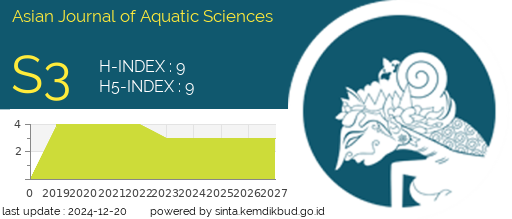CORRELATION BETWEEN THE AMOUNT OF ORGANIC MATTER AND THE ABUNDANCE OF MACROZOOBENTHOS IN THE COASTAL WATERS OF DUMAI CITY
DOI:
https://doi.org/10.31258/Keywords:
Dumai, Macrozoobenthos, Organic MatterAbstract
This research was conducted in March 2022 in the Coastal Waters of Dumai City. This
study aims to analyze the amount of organic matter and the abundance of macrozoobenthos
and the relationship between the amount of organic matter and the abundance of
macrozoobenthos. The method used is a survey method consisting of 10 stations with 2
replications at each station. And 1 station is a control station located on the north coast of
North Rupat District, Bengkalis Regency. Sediment sampling was carried out in the field and
then taken to the Marine Chemistry Laboratory, Riau University for analysis of organic matter
and macrozoobenthos analysis. Based on a simple linear regression test, the relationship
between the amount of organic matter and the abundance of macrozoobenthos obtained a
correlation value (r) = -0. 4637 with the mathematical equation y = -4.884x + 98.896. The test
results show a weak and inverse relationship between the amount of organic matter and the
abundance of macrozoobenthos. This means that with the increase in the amount of organic
matter, the abundance of macrozoobenthos in the coastal waters of Dumai City will decrease.
The value of the coefficient of determination (R2
) is 0.2146. This figure shows that the effect
of organic matter on the abundance of macrozoobenthos is small, namely 21.46%.
Downloads
References
Lintano DA, Mubarak M, Sutikno S. Studi pemanfaatan ruang dan kejadian banjir di
wilayah pesisir Kota Dumai. Jurnal Zona, 2017; 1(1) : 35–44.
2. Lubis NA, Nedi S, Effendi I. Level of water pollution based on organic material
parameters and number of bacteria Escherichia coli in Dumai River Estuary, Dumai
City. Journal of Coastal and Ocean Sciences, 2021; 2(2): 146–153.
3. Citra LS, Supriharyono S, Suryanti S. Analisis kandungan bahan organik, nitrat dan
fosfat pada sedimen mangrove jenis Avicennia dan Rhizophora di Desa Tapak
Tugurejo, Semarang. Management of Aquatic Resources Journal (MAQUARES),
2020; 9(2): 107–114. https://doi.org/10.14710/marj.v9i2.27766.
4. Supriyantini E, Soenardjo N, Nurtania SA. Konsentrasi bahan organik pada perairan
mangrove di Pusat Informasi Mangrove (PIM), Kecamatan Pekalongan Utara, Kota
Pekalongan. Buletin Oseanografi Marina, 2017; 6(1): 1-8.
5. Mauludy MS, Yunanto A, Yona D. Kelimpahan mikroplastik pada sedimen pantai
wisata Kabupaten Badung, Bali. Jurnal Perikanan Universitas Gajah Mada. 2019,
21(2): 73-78.
6. Barus BS, Aryati R, Putri WAE, Nurjuliasti E, Diansyah G, Sitorus E. Hubungan ntotal dan c-organik sedimen dengan makrozoobentos di perairan Pulau Payung,
Banyuasin, Sumatera Selatan. Jurnal Kelautan Tropis, 2019; 22(2): 147-156
7. Yunitawati, Sunarto, Hasan Z. Hubungan antara karakteristik substrat dengan struktur
komunitas makrozoobenthos di Sungai Cantigi, Kabupaten Indramayu. Jurnal
Perikanan dan Kelautan. 2012; 3(3): 221-227.
8. Rahayu S, Mahatma R, Khairijon. Kelimpahan dan keanekaragaman makrozoobentos
di beberapa anak Sungai Batang Lubuh Kecamatan Rambah, Kabupaten Rokan Hulu.
JOM FMIPA, 2015; 2(1): 198-208.







